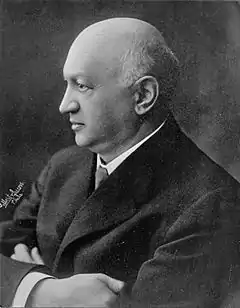Siegmund Lubin | |
|---|---|
 Lubin in 1913 | |
| Born | Zygmunt Lubszyński April 20, 1851 |
| Died | September 11, 1923 (aged 72) |
| Nationality | German, US |
| Other names | Siegmund Lubszynski "Pop" Lubin |
| Occupation(s) | Optometrist, inventor, film-maker, industrialist |
| Spouse |
Annie Abrams (m. 1882–1923) |
Siegmund Lubin (born Zygmunt Lubszyński, April 20, 1851 – September 11, 1923) was an American motion picture pioneer who founded the Lubin Manufacturing Company (1902–1917) of Philadelphia.
Biography
Siegmund Lubin was born as Zygmunt Lubszyński, a son of Samuel Lubszyński and Rebeka Lubszyńska, Polish Jews, in Breslau, Kingdom of Prussia (now Wrocław, Poland) or in Poznań, Kingdom of Prussia on April 20, 1851. His father, a successful ophthalmologist,[1] moved the family for economic reasons to Berlin soon after Zygmunt's birth. There young Zygmunt Germanicized the spelling of his first name to Siegmund. He later graduated from the Heidelberg University and in 1876 emigrated to the United States, where he settled in Philadelphia and worked as an optometrist.[2] Around 1881, he shortened his surname from the Polish Lubszyński to Lubin.
He soon progressed to making his own camera and projector combination, which he sold. In 1896 he began distributing films for Thomas Edison. In 1897 he started making films and in 1902 formed the Lubin Manufacturing Company, incorporating it in 1909. He made the film Meet Me at the Fountain in 1904.[2] His company also sold illegally copied prints of many films by other directors, notably those of Georges Méliès, making Lubin one of the foremost early practitioners of film piracy.[3]
By 1910 his company had built a film studio, "Lubinville", in Philadelphia,[2] at Twentieth and Indiana Streets.[1] A fire at its studio in June 1914 destroyed the negatives for his unreleased new films. When World War I broke out in Europe in September of that year, Lubin Studios was among the American filmmakers who lost foreign sales. The Lubin Film Company went out of business on September 1, 1917, after having made more than a thousand motion pictures. Siegmund went back to work as an optometrist.
.jpg.webp)
He died on September 11, 1923, at his home in Ventnor, New Jersey.[2][4] He was buried on September 14, 1923.[5]
Legacy
For his contribution to the motion picture industry, Siegmund Lubin has a star on the Hollywood Walk of Fame (with his first name as "Sigmund") at 6166 Hollywood Blvd.[6]
References
- 1 2 "Sigmund Lubin: Lubinville, PA". Paul Falzone;MINTV35; YouTube. Independence Media. Retrieved 31 May 2013.
- 1 2 3 4 Joseph P. Eckhardt. "Lubin Timeline". Montgomery County Community College. Retrieved 2011-11-25.
- ↑ Frazer, John (1979), Artificially Arranged Scenes: The Films of Georges Méliès, Boston: G. K. Hall & Co., p. 71, ISBN 0816183686,
Siegmund Lubin of Philadelphia was the most notorious film duper of the primitive cinema. He was a major contributor to Méliès' difficulties before 1903, the date when Star Films were first copyrighted through the Library of Congress.
- ↑ "Siegmund Lubin Dies. Pioneer in Movies. Philadelphia Optician, Once a Producer, Succumbs to Heart Disease at 72". New York Times. September 11, 1923. Retrieved 2011-11-25.
- ↑ "Siegmund Lubin Buried". New York Times. September 15, 1923. Retrieved 2011-11-25.
Sigmund Lubin, pioneer motion picture producer, was buried today In the ... of this city, died on Wednesday in Padgewood [sic], NJ. He was 82 [sic] years old. ...
- ↑ "Sigmund Lubin-Hollywood Star Walk". Los Angeles Times. Retrieved 31 May 2013.
External links
- Works by or about Siegmund Lubin at Internet Archive
- The King of the Movies: Film Pioneer, Siegmund Lubin - biographical page with time line and other material by Joseph P. Eckhardt, Professor of History, Montgomery County Community College
- Lubinville (film) on YouTube
- WHYY, Ed Cunningham's Philadelphia, Siegmund Lubin, Video
- Siegmund Lubin: King of the Movies,
Betzwood, Digital History from the Libraries of Montgomery County Community College